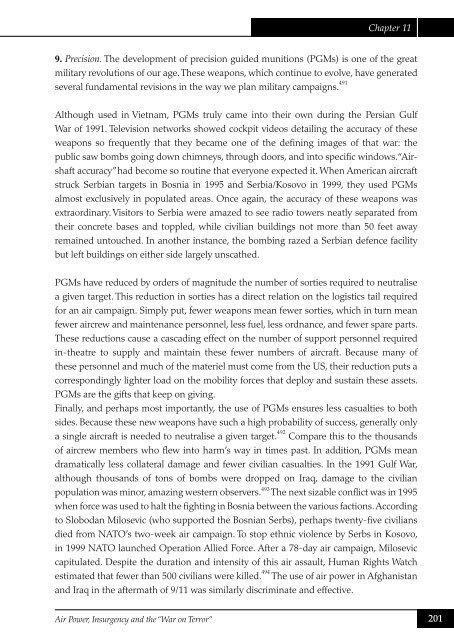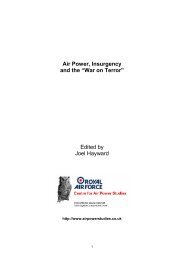Air Power, Insurgency and the âWar on Terrorâ - Prof. Joel Hayward's ...
Air Power, Insurgency and the âWar on Terrorâ - Prof. Joel Hayward's ...
Air Power, Insurgency and the âWar on Terrorâ - Prof. Joel Hayward's ...
Create successful ePaper yourself
Turn your PDF publications into a flip-book with our unique Google optimized e-Paper software.
Chapter 11<br />
9. Precisi<strong>on</strong>. The development of precisi<strong>on</strong> guided muniti<strong>on</strong>s (PGMs) is <strong>on</strong>e of <str<strong>on</strong>g>the</str<strong>on</strong>g> great<br />
military revoluti<strong>on</strong>s of our age. These weap<strong>on</strong>s, which c<strong>on</strong>tinue to evolve, have generated<br />
several fundamental revisi<strong>on</strong>s in <str<strong>on</strong>g>the</str<strong>on</strong>g> way we plan military campaigns. 491<br />
Although used in Vietnam, PGMs truly came into <str<strong>on</strong>g>the</str<strong>on</strong>g>ir own during <str<strong>on</strong>g>the</str<strong>on</strong>g> Persian Gulf<br />
War of 1991. Televisi<strong>on</strong> networks showed cockpit videos detailing <str<strong>on</strong>g>the</str<strong>on</strong>g> accuracy of <str<strong>on</strong>g>the</str<strong>on</strong>g>se<br />
weap<strong>on</strong>s so frequently that <str<strong>on</strong>g>the</str<strong>on</strong>g>y became <strong>on</strong>e of <str<strong>on</strong>g>the</str<strong>on</strong>g> defining images of that war: <str<strong>on</strong>g>the</str<strong>on</strong>g><br />
public saw bombs going down chimneys, through doors, <str<strong>on</strong>g>and</str<strong>on</strong>g> into specific windows. “<str<strong>on</strong>g>Air</str<strong>on</strong>g>shaft<br />
accuracy” had become so routine that every<strong>on</strong>e expected it. When American aircraft<br />
struck Serbian targets in Bosnia in 1995 <str<strong>on</strong>g>and</str<strong>on</strong>g> Serbia/Kosovo in 1999, <str<strong>on</strong>g>the</str<strong>on</strong>g>y used PGMs<br />
almost exclusively in populated areas. Once again, <str<strong>on</strong>g>the</str<strong>on</strong>g> accuracy of <str<strong>on</strong>g>the</str<strong>on</strong>g>se weap<strong>on</strong>s was<br />
extraordinary. Visitors to Serbia were amazed to see radio towers neatly separated from<br />
<str<strong>on</strong>g>the</str<strong>on</strong>g>ir c<strong>on</strong>crete bases <str<strong>on</strong>g>and</str<strong>on</strong>g> toppled, while civilian buildings not more than 50 feet away<br />
remained untouched. In ano<str<strong>on</strong>g>the</str<strong>on</strong>g>r instance, <str<strong>on</strong>g>the</str<strong>on</strong>g> bombing razed a Serbian defence facility<br />
but left buildings <strong>on</strong> ei<str<strong>on</strong>g>the</str<strong>on</strong>g>r side largely unsca<str<strong>on</strong>g>the</str<strong>on</strong>g>d.<br />
PGMs have reduced by orders of magnitude <str<strong>on</strong>g>the</str<strong>on</strong>g> number of sorties required to neutralise<br />
a given target. This reducti<strong>on</strong> in sorties has a direct relati<strong>on</strong> <strong>on</strong> <str<strong>on</strong>g>the</str<strong>on</strong>g> logistics tail required<br />
for an air campaign. Simply put, fewer weap<strong>on</strong>s mean fewer sorties, which in turn mean<br />
fewer aircrew <str<strong>on</strong>g>and</str<strong>on</strong>g> maintenance pers<strong>on</strong>nel, less fuel, less ordnance, <str<strong>on</strong>g>and</str<strong>on</strong>g> fewer spare parts.<br />
These reducti<strong>on</strong>s cause a cascading effect <strong>on</strong> <str<strong>on</strong>g>the</str<strong>on</strong>g> number of support pers<strong>on</strong>nel required<br />
in-<str<strong>on</strong>g>the</str<strong>on</strong>g>atre to supply <str<strong>on</strong>g>and</str<strong>on</strong>g> maintain <str<strong>on</strong>g>the</str<strong>on</strong>g>se fewer numbers of aircraft. Because many of<br />
<str<strong>on</strong>g>the</str<strong>on</strong>g>se pers<strong>on</strong>nel <str<strong>on</strong>g>and</str<strong>on</strong>g> much of <str<strong>on</strong>g>the</str<strong>on</strong>g> materiel must come from <str<strong>on</strong>g>the</str<strong>on</strong>g> US, <str<strong>on</strong>g>the</str<strong>on</strong>g>ir reducti<strong>on</strong> puts a<br />
corresp<strong>on</strong>dingly lighter load <strong>on</strong> <str<strong>on</strong>g>the</str<strong>on</strong>g> mobility forces that deploy <str<strong>on</strong>g>and</str<strong>on</strong>g> sustain <str<strong>on</strong>g>the</str<strong>on</strong>g>se assets.<br />
PGMs are <str<strong>on</strong>g>the</str<strong>on</strong>g> gifts that keep <strong>on</strong> giving.<br />
Finally, <str<strong>on</strong>g>and</str<strong>on</strong>g> perhaps most importantly, <str<strong>on</strong>g>the</str<strong>on</strong>g> use of PGMs ensures less casualties to both<br />
sides. Because <str<strong>on</strong>g>the</str<strong>on</strong>g>se new weap<strong>on</strong>s have such a high probability of success, generally <strong>on</strong>ly<br />
a single aircraft is needed to neutralise a given target. 492 Compare this to <str<strong>on</strong>g>the</str<strong>on</strong>g> thous<str<strong>on</strong>g>and</str<strong>on</strong>g>s<br />
of aircrew members who flew into harm’s way in times past. In additi<strong>on</strong>, PGMs mean<br />
dramatically less collateral damage <str<strong>on</strong>g>and</str<strong>on</strong>g> fewer civilian casualties. In <str<strong>on</strong>g>the</str<strong>on</strong>g> 1991 Gulf War,<br />
although thous<str<strong>on</strong>g>and</str<strong>on</strong>g>s of t<strong>on</strong>s of bombs were dropped <strong>on</strong> Iraq, damage to <str<strong>on</strong>g>the</str<strong>on</strong>g> civilian<br />
populati<strong>on</strong> was minor, amazing western observers. 493 The next sizable c<strong>on</strong>flict was in 1995<br />
when force was used to halt <str<strong>on</strong>g>the</str<strong>on</strong>g> fighting in Bosnia between <str<strong>on</strong>g>the</str<strong>on</strong>g> various facti<strong>on</strong>s. According<br />
to Slobodan Milosevic (who supported <str<strong>on</strong>g>the</str<strong>on</strong>g> Bosnian Serbs), perhaps twenty-five civilians<br />
died from NATO’s two-week air campaign. To stop ethnic violence by Serbs in Kosovo,<br />
in 1999 NATO launched Operati<strong>on</strong> Allied Force. After a 78-day air campaign, Milosevic<br />
capitulated. Despite <str<strong>on</strong>g>the</str<strong>on</strong>g> durati<strong>on</strong> <str<strong>on</strong>g>and</str<strong>on</strong>g> intensity of this air assault, Human Rights Watch<br />
estimated that fewer than 500 civilians were killed. 494 The use of air power in Afghanistan<br />
<str<strong>on</strong>g>and</str<strong>on</strong>g> Iraq in <str<strong>on</strong>g>the</str<strong>on</strong>g> aftermath of 9/11 was similarly discriminate <str<strong>on</strong>g>and</str<strong>on</strong>g> effective.<br />
<str<strong>on</strong>g>Air</str<strong>on</strong>g> <str<strong>on</strong>g>Power</str<strong>on</strong>g>, <str<strong>on</strong>g>Insurgency</str<strong>on</strong>g> <str<strong>on</strong>g>and</str<strong>on</strong>g> <str<strong>on</strong>g>the</str<strong>on</strong>g> “War <strong>on</strong> Terror” 201





